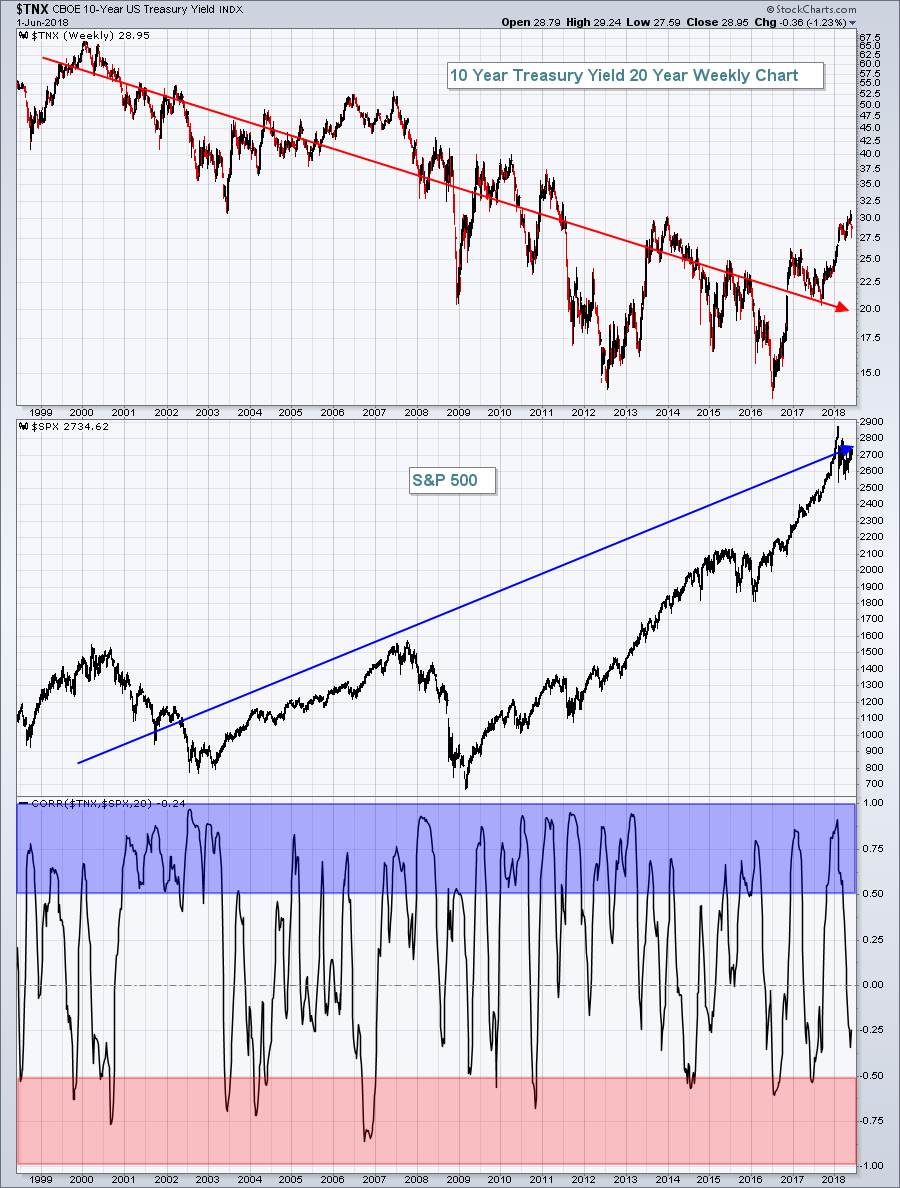While many market pundits seemed to grow very concerned about the 10 year treasury yield ($TNX) rising to 7 year highs at its recent 3.11% peak, I only grow nervous when the TNX falls. Why? Well, rising rates are typically a precursor to economic strength. The S&P 500 ($SPX) has a strong positive correlation with the direction of the TNX. It might go against common sense as many believe that rising rates will slow our economy. At some point, that could be the case, but not when we're near all-time low levels on the TNX. Interest rates are at very low historical levels and rising from this level is VERY BULLISH for equities. Let's take a look at that TNX and SPX correlation:
 At first glance, there appears to be a negative correlation. After all, the S&P 500 has moved much higher over the past two decades while the TNX has been dropping. So how can there be a positive correlation? Well, there is. Look at the blue shaded area that shows the correlation indicator reaching the "strong positive correlation" area between 0.50 and 1.00. It happens quite often. Then look at the red shaded area that shows the correlation indicator reaching the "strong negative correlation" area between -0.50 and -1.00. That happens much less frequently.
At first glance, there appears to be a negative correlation. After all, the S&P 500 has moved much higher over the past two decades while the TNX has been dropping. So how can there be a positive correlation? Well, there is. Look at the blue shaded area that shows the correlation indicator reaching the "strong positive correlation" area between 0.50 and 1.00. It happens quite often. Then look at the red shaded area that shows the correlation indicator reaching the "strong negative correlation" area between -0.50 and -1.00. That happens much less frequently.
Over the long-term, the TNX and SPX can move in different directions. In the short- to intermediate-term, however, they tend to move together as the mostly positive correlation reflects. There are two dynamics that drive this intermarket relationship:
(1) New money coming into both markets. Inflows can send both the equity and bond markets higher. When bond prices rise, yields always drop. There is a 100% inverse relationship between bond prices and bond yields. They always move opposite one another. So if both equity prices and bond prices are moving up, then the TNX will move opposite the S&P 500 (negative correlation) from time to time.
(2) Rotation between these two asset classes. This is the critical consideration. Money managers routinely change their asset allocation models, investing more heavily in either bonds or stocks. As economic conditions improve, returns on equities almost always outperform bonds. But those strengthening economic conditions also coincide with higher rates to prevent an overheating economy. It's the Fed's job to monitor economic conditions and then set interest rate policy accordingly. The bond market predicts the Fed's actions. If higher rates are expected based on strengthening economic conditions, bonds are sold and yields rise. The stock market also benefits from better economic conditions as profits rise, sending equity prices higher. That is where the positive correlation comes in.
I believe the nearly four decade drop in treasury yields has ended. I expect to see a 4.00%-5.00% yield on the TNX over the next 1-2 years. That means A TON of money will be rotating away from the bond market, the first such major selling of bonds in 40 years. That will ignite an already robust U.S. stock market.
When economic conditions are strengthening, treasury yields rise, transportation stocks ($TRAN) perform very well, and utilities ($UTIL) suffer. The stock market is already anticipating this scenario as the TRAN:UTIL ratio is quite bullish and on the rise again, despite the recent drop in the TNX:
 The increased volatility in Q1 2018 resulted in consolidation of the S&P 500 and a down channel for the TRAN:UTIL ratio. Both have broken out of those patterns, however, and I believe are signaling yet another rise in U.S. equities. The summer months do tend to provide seasonal headwinds for equities so large gains might have to wait until Q4, but I'm convinced U.S. equities are heading much, much higher.
The increased volatility in Q1 2018 resulted in consolidation of the S&P 500 and a down channel for the TRAN:UTIL ratio. Both have broken out of those patterns, however, and I believe are signaling yet another rise in U.S. equities. The summer months do tend to provide seasonal headwinds for equities so large gains might have to wait until Q4, but I'm convinced U.S. equities are heading much, much higher.
I've written quite a bit about dollar strength ($USD) and resulting outperformance by the small cap Russell 2000 ($RUT). I expect that to continue, although the USD is pulling back from overhead resistance at 95. If that resistance is cleared, look for a strong summer from the small cap stocks to extend its spring rally.
For a look at the USD and its impact on small caps, check out my Friday Trading Places blog article, "Small Caps Enter Their Best Relative Strength Month On A Roll". Please scroll to the bottom of this article and to the bottom of my Trading Places blog article, type in your email address and hit the green "Subscribe" button. Your subscription is FREE and you'll receive my commentary as soon as it's published. Thanks so much for your continuing support!
Happy trading!
Tom





